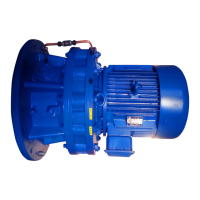72
9. Troubleshooting
Common
If any abnormal condition occurs, refer to Table 9-1, 9-2 and promptly take appropriate measures.
If these actions do not remedy the issue, immediately contact the nearest authorized service station.
Table 9-1 Troubleshooting
Problem Cause Correction
The motor will not operate under no load
Power failure Contact the electric power company.
Defective electric circuit Check the circuit.
Blown fuse Replace the fuse.
Protective device is engaged Fix the problem and recover.
Load locking Check the load and safety device.
Poor switch contact Adjust the contact unit.
Motor stator coil disconnect Confer with authorized service station.
Bearing damage Confer with authorized service station.
3-phase is functioning as single-phase
Check the power supply with a voltmeter.
Check the motor, transformer coil, contactor,
fuse, etc. and repair or replace them.
Friction surface of brake is corroded
Request brake cleaning from authorized
service station.
Incorrect brake gap adjustment
Re-adjust brake gap.
(See P47 – 68)
The motor rotates without a load but the
slow speed shaft does not rotate
Damage to gear unit due to overloading of
gears, etc.
Confer with authorized service station.
The slow speed shaft turns without a load
When a load is applied
The switch overheats
Insucient switch capacity Replace with specied switch.
Overload Decrease the load to the specied value.
Fuse tripping
Insucient fuse capacity Replace with specied fuse.
Overload Decrease the load to the specied value.
The speed will not increase and
the motor is overheating
Voltage drop Contact the electric power company.
Overload Decrease the load to the specied value.
Short-circuited motor stator coil Confer with authorized service station.
It stops
The key is not inserted Insert key.
Bearing burnout Confer with authorized service station.
Poor adjustment of protection device Adjust the protection device.
The motor runs in the reverse
direction
Wiring error Change the connection.
Fuse tripping
The lead wire is short circuited. Confer with authorized service station.
Poor contact between motor and starter Make good connection.
Excessive temperature rise
Overload Decrease the load to the specied value.
Voltage drop or rise Contact the electric power company.
The ambient temperature is high Improve the ventilation method.
Damaged bearing Confer with authorized service station.
Abnormal wear of reducer parts due to
overload, etc.
Confer with authorized service station.
Oil leakage
Blot or drip of a small amount of
oil or grease at seal section of high
speed or slow speed shaft
Grease applied to the oil seal seeps out at rst Wipe o around the oil seal, and observe.
Leakage of oil or grease from high
speed or slow speed shaft section
Damaged oil seal or maybe damaged shaft (or
collar)
Confer with authorized service station.
Leakage of oil/grease from the
contact surfaces of ring gear housing
and casing, etc.
Loose fastener bolts Tighten fastener bolts correctly.
Leakage of oil/grease into motor
Damage to oil seals, or slinger collar Confer with authorized service station.
Excessive oil supply Remove oil.

